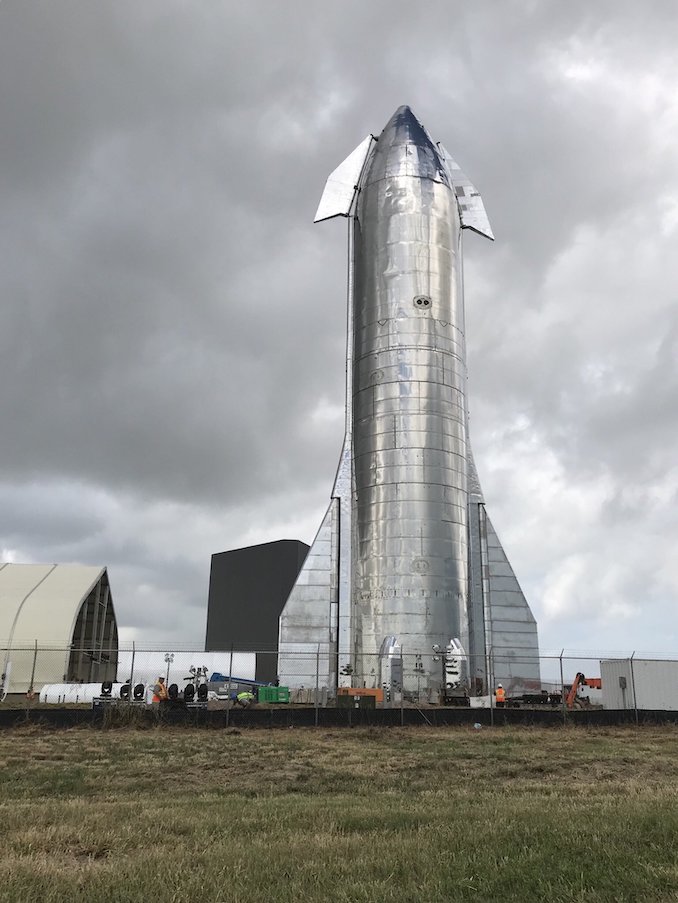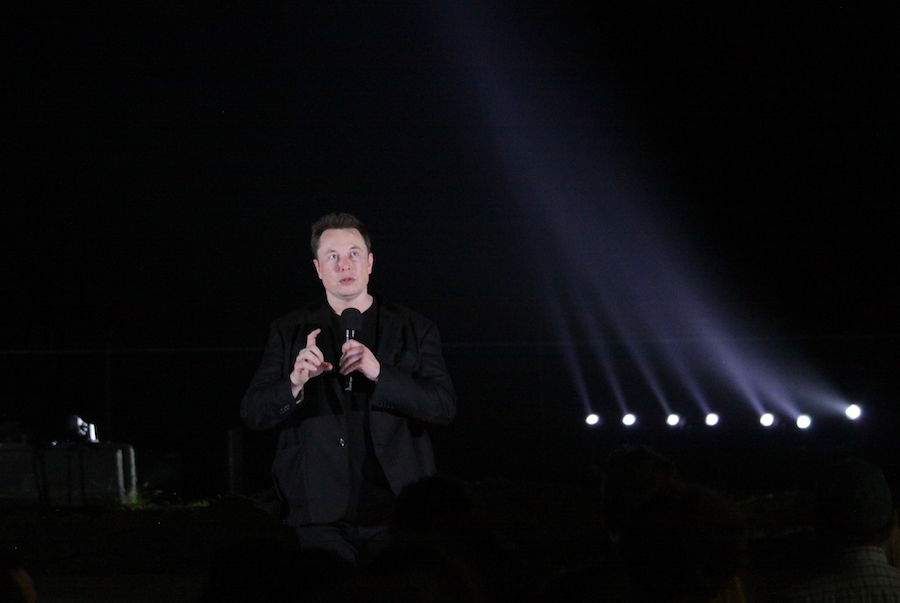Elon Musk wants to move fast with SpaceX’s Starship – Spaceflight Now

Standing in front of a shiny full-scale prototype of SpaceX’s Starship vehicle in South Texas, Elon Musk said Saturday night he wants the company’s gigantic next-generation rocket to fly into orbit within six months, a bold schedule that he acknowledged requires “exponential” improvements in design and manufacturing.
Regardless of when the futuristic-looking vehicle reaches orbit for the first time, Musk told several hundred employees, local supporters, space enthusiasts and space reporters — along with thousands more watching online — that SpaceX will build a fleet of Starships and launch them from sites in Texas and Florida.
The first full-size prototype of SpaceX’s Starship space vehicle — named Starship Mk. 1 and built this summer on the South Texas coast — should be ready to launch on a high-altitude atmospheric test flight in the next one or two months, Musk said.
SpaceX plans to practice launching and landing the Starship with suborbital up-and-down flights, similar to the way engineers perfected landings of Falcon rocket boosters with an experimental vehicle named “Grasshopper.”
“What’s really kind of hard to grasp, at a visceral level, is that this giant ship will do the same thing that Grasshopper did,” Musk said, backdropped by the Starhopper prototype. “This thing is going to take off, fly to 65,000 feet — about 20 kilometers — and come back and land in about one to two months… So that giant thing, it’s really going to be pretty epic to see that thing take off and come back.”
“Yeah, it’s wild,” he added.
Musk, an avowed optimist, said an orbital launch attempt with Starship, and its not-yet-built Super Heavy first stage booster, could happen next year.
“With any development into uncharted territory, it’s difficult to predict these things with precision,” he said. “But I do think things are going to move very fast. So, our plan is in basically in one to two months to do the 20-kilometer flight with Starship Mk. 1. Our next flight after that might actually just be all the way to orbit with a booster and the ship.”
SpaceX says the reusable Starship and Super Heavy will eventually replace the company’s Falcon 9 and Falcon Heavy rockets, along with the Dragon cargo and crew capsules.
According to SpaceX’s website, the Starship and Super Heavy will be able to deliver satellites to orbit at a “lower marginal cost per launch than our current Falcon vehicles.” But SpaceX says the next-generation booster and spaceship can do much more, including interplanetary flights to the moon, Mars and other destinations with up to 150 tons of cargo, or crews of up to 100 people.
SpaceX is building a second Starship prototype, designated Mk. 2, at an industrial yard in Cocoa, Florida, near Cape Canaveral. Once complete, the vehicle will be transported to the nearby Kennedy Space Center for testing at launch pad 39A, a former Apollo and space shuttle launch facility now leased by SpaceX for its Falcon rocket family.
“I’m giving you literally just stream of consciousness here,” Musk said Saturday at SpaceX’s launch site at Boca Chica, Texas. “Most likely, we would not fly to orbit with Mk 1, but we would fly to orbit with Mk. 3, which will be built after Mk. 1 right here. In fact, we’ll start building it in about a month.
“Just to frame things, we are going to be building ships and boosters at both Boca and the Cape as fast as we can,” he said. “It’s going to be really nutty to see a bunch of these things, not just one, but a whole stack of them. We’re improving both the design and the manufacturing method exponentially.”
For example, the third iteration of SpaceX’s Starship will be built in fewer pieces, with thinner walls, a lighter structure, and lower costs, he said.
“The rate at which we’re going to be building ships will be quite crazy by space standards,” he said. “I think we’ll have Mk. 2 (in Florida) built within a couple of months or less, and Mk. 3, maybe three months, that type of thing. Mk. 4, four months, maybe five months. And we would seek to go to orbit with probably Mk. 4 or Mk. 5.”
“This is going to sound totally nuts, but I think we want to try to reach orbit in less than six months,” Musk said. “Provided the rate of design improvement and manufacturing improvement continue to be exponential, I think that is accurate to within a few months.”

So far, SpaceX’s development of the Super Heavy and Starship has been privately-funded through revenues from Falcon and Dragon missions. SpaceX has also raised more than $1 billion this year from investors, largely to fund the company’s Starlink program designed to provide Internet services from space.
SpaceX says future revenue from the Starlink business could be applied to the Super Heavy and Starship projects.
“The priority is to build at least two Starships at each site — at Boca and at the Cape — and then start building the (Super Heavy) booster,” Musk said. “We’ll complete Mk. 1 through 4 before doing Mk. 1 of the booster. And then we’ll do Mk. 1 and Mk. 2 of the boosters at the Cape and at Boca.”
Clusters of methane-fueled Raptor engines will power the Super Heavy and Starship vehicles.
Three Raptors are mounted to the base of the Starship Mk. 1 prototype at Boca Chica, and three more will be installed on the Mk. 2 vehicle in Florida for initial test flights, Musk said.
The Raptor is the most powerful engine ever built by SpaceX. The early version of the Raptor engine can produce up to 440,000 pounds of thrust at sea level, roughly equivalent to the main engines flown on the space shuttle.
Orbital-class Starships will have six Raptors– three gimbaling center-mounted engines for vertical landings, and three engines with expanded nozzles optimized for firings in space.
The Super Heavy booster could accommodate up to 37 Raptor engines, depending on final design decisions and mission requirements, Musk said. He expects the Super Heavy to generate around 15 million pounds of thrust at liftoff, about two times the thrust generated by the gigantic Saturn 5 rocket used for the Apollo moon landing missions.
“The main constraint on launching the booster is engines,” Musk said. “The booster has a lot of engines. So spooling up the Raptor production rate is extremely important — vital — to completing the booster. Doing the tanks and the legs and the grid fins, that is not a constraint. That we can get done fast. I think we’d want to have at least probably 24 engines, but I think really at least 31 engines to launch.
“Including development engines from now through orbit, we probably need 100 Raptor engines. Our production rate right now is maybe one every eight to 10 days,” he said.
By next year, SpaceX wants to build a Raptor engine every day.
The Starship vehicle assembled at Boca Chica stands around 164 feet (50 meters) tall and weighs 200 tons without propellants. It measures around 30 feet (9 meters) in diameter, about one-and-a-half times the diameter of a Boeing 747 jumbo jet.
Musk, an avowed optimist, said people could ride into space on Starship flights before the end of next year.
“I think we could potentially see people flying next year,” he said. “It’s designed to be a reusable rocket, so we can do many flights to prove out the reliability very quickly. With an expendable vehicle, if you want to do 10 flights, let’s say, to prove out the viability of an expendable vehicle, you need to build and destroy 10 vehicles, whereas we can do 10 flights within basically 10 days.
“When I say rapid reusability, I mean you can fly the booster 20 times a day, you fly the ship three or four times a day. That’s what I mean by reusability.”
Japanese billionaire Yusaku Maezawa announced last year he plans to fly on SpaceX’s next-generation spaceship, along with a crew of artists, on a flight around the moon as soon as 2023.
SpaceX says the “aspirational goal” is to make the Starship ready for a flight to Mars without humans in 2022. A crewed flight to the Red Planet could follow as soon as 2024.
While he didn’t mention it Saturday night, Musk has previously said the Starship could be used for point-to-point transportation around Earth, enabling intercontinental flights in minutes instead of hours.

Musk’s presentation Saturday was heavy on propulsion systems, structural design, aerodynamics and vision, but light on talk of funding or technologies necessary to sustain Starship crews in space, which SpaceX says may number as many as 100 people at a time.
“For sure, you’d want to have a regenerative live support system,” Musk said in response to a question. “That just means you’re recycling everything. That’s for sure important if you’re on a several-month journey to Mars and on the surface for 18 months. Regenerative is kind of a necessity. I don’t think it’s actually super-hard to do that relative to the spacecraft itself. The life support system is pretty straightforward.”
Musk suggested work on life support systems will come later because the Starship’s first flights will be unpiloted.
“The early flights of Starship would not have any people on-board,” he said. “It would just be in automatic mode. It would only be later flights that would have people on-board. Even the first flights to Mars, we would send at least a couple of ships, (and) have them land automatically before sending people.”
SpaceX’s Crew Dragon capsule, designed to ferry NASA astronauts to the International Space Station, will be the company’s first human-rated spaceship. But it’s designed for a limited purpose, and has basic life support systems to accommodate crews for a few days during trips to and from the space station.
For long-duration voyages to other other worlds, SpaceX’s Starship will need a much more elaborate life support system to regulate oxygen and carbon dioxide in the atmosphere, store and process human waste, generate drinking water, and perhaps grow vegetables on-board.
NASA is testing some “closed-loop” life support system technologies on the space station, with more upgrades set for launch to the orbiting research complex in the next few years.
Email the author.
Follow Stephen Clark on Twitter: @StephenClark1.






